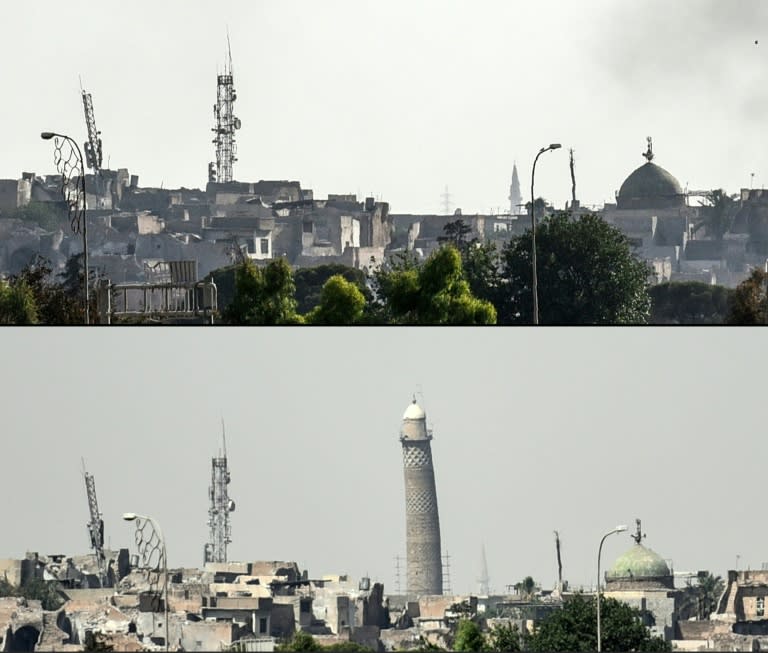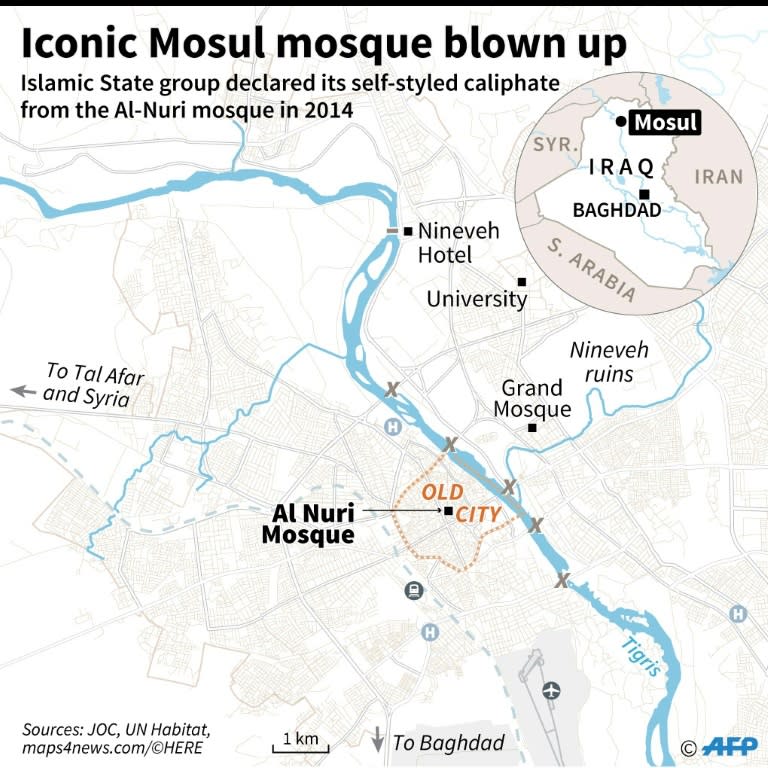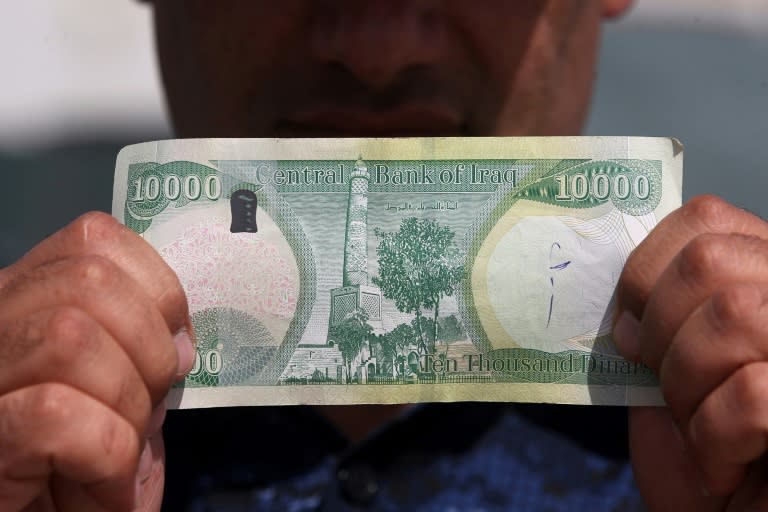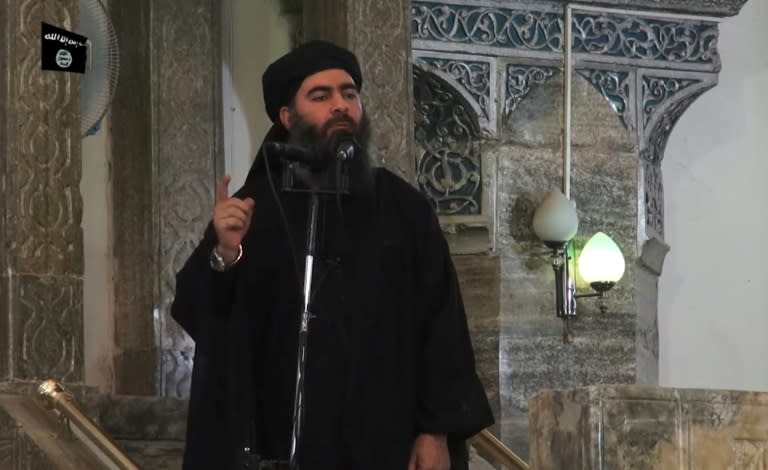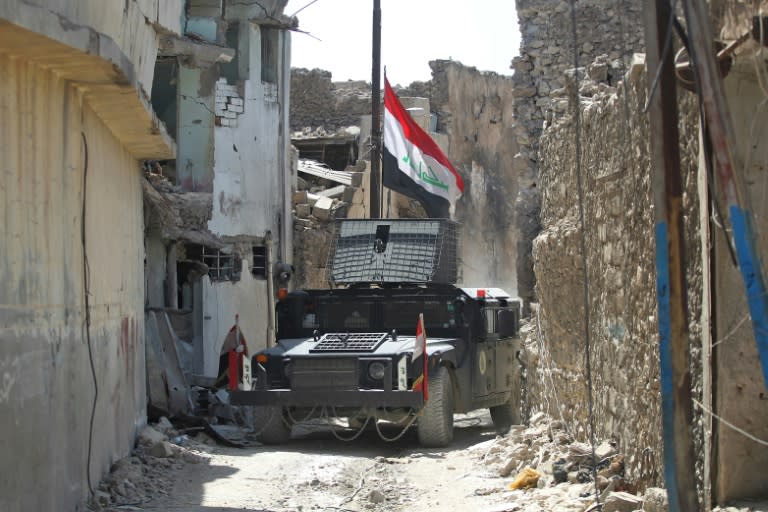IS destroys iconic Mosul minaret as Iraqi forces advance
Mosul's trademark leaning minaret was missing from its skyline for the first time in centuries Thursday after desperate jihadists blew it up as Iraqi forces advanced on an ancient mosque compound in the embattled northern city. Explosions on Wednesday evening levelled both the Nuri mosque where Abu Bakr al-Baghdadi gave his first sermon as leader of the Islamic State group and its ancient leaning minaret, known as the "Hadba" (Hunchback). Officials from Iraq and the US-led anti-IS coalition said the destruction of the site was a sign of the jihadist group's imminent loss of Mosul, with Prime Minister Haider al-Abadi calling it an "official declaration of defeat". The loss of the iconic 12th century minaret -- one of the country's most recognisable monuments sometimes referred to as Iraq's Tower of Pisa -- left the country in shock. But the destruction had been widely anticipated, with commanders saying IS, also known as ISIS and Daesh, would not have allowed Iraqi forces to score a hugely symbolic victory by recapturing the site. "They blew up this place in an attempt to cover up their heavy losses in the media, but the media and the people see the victories and see the collapse of Daesh," Brigadier General Falah Fadel al-Obeidi, from the elite Counter-Terrorism Service, told AFP in Mosul. IS claimed on its Amaq propaganda agency that the site was hit in a US air strike, but the US-led coalition said it was the jihadists who had "destroyed one of Mosul and Iraq's great treasures". Baghdadi made his only public appearance as IS leader there in July 2014, when he urged the world's Muslims to join his "caliphate" straddling Iraq and Syria. Russia has said it is seeking to verify whether Baghdadi, whose whereabouts have been unknown for months, was killed when its warplanes hit the group's leaders in a night air raid in Syria last month. - 'Deepens the wounds' - On the mosque destruction, Brett McGurk, the US envoy to the coalition, said it was the "clearest sign yet of desperation and defeat" from the jihadists. While some Iraqis mourned the loss of a piece of their cultural identity, others stressed that the destructions were dwarfed by the ongoing human suffering. The head of the UN's cultural agency, Irina Bokova, said "this new destruction deepens the wounds of a society already affected by an unprecedented humanitarian tragedy". Ihsan Fethi, an Iraqi architect and heritage expert said the minaret had come to "symbolise the defiance of Mosul and its people in the face of so many hardships and foreign attacks." "It has stood there, so tall and so proud, for over 845 years as a watchful monument and an impressive icon for this great cultural city until yesterday," he wrote. The destruction of the site in Mosul's Old City adds to a long list of priceless heritage and historical monuments destroyed by IS during its three-year rule over parts of Iraq and Syria. The minaret, which was completed in 1172 and has been listing for centuries, is featured on Iraq's 10,000-dinar banknote and was the main symbol of Iraq's second city -- giving its name to countless restaurants, companies and even sports clubs in Mosul. After seizing Iraq's Sunni Arab heartland in June 2014, IS reportedly rigged the Hadba with explosives but was prevented from blowing it up by the local population. The jihadists consider the reverence of objects, including of such sites, as heresy. Iraqi forces had been approaching the Nuri mosque on Wednesday, three days after launching an assault to retake the Old City, the last district of Mosul still under IS control. About 100,000 residents are believed to still be trapped in the Old City by IS, which has been using civilians as human shields to defend its last redoubt in Mosul. - Mosul battle not over - The area still controlled by the jihadists is small but its narrow streets and the presence of so many civilians has made the operation perilous. Two journalists were killed on Monday and two others wounded in a mine blast near the Old City and reports by medics and rights groups suggest that trapped civilians are paying a heavy price. The jihadists have been offering fierce resistance in the Old City, with barrages of mortar fire and a huge number of booby traps slowing the Iraqi advance. While Iraqi forces have made good progress to reach the Nuri mosque, Iraqi commanders have warned that the battle for the Old City is far from over. When asked about the explosions that forever changed the face of the city on Wednesday, one west Mosul resident said that human lives remained more important than any historical monument. "Although it was Mosul's symbol and icon, there are people who have been killed. They are much more precious than the minaret," 38-year-old Yasser Ali told AFP.

